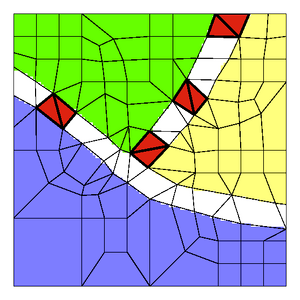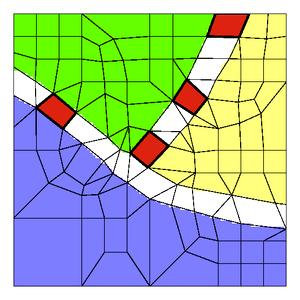OOF2: The Manual
Name
Merge Triangles (MergeTriangles) — Merge neighboring homogeneous triangles to form quadrilaterals.
Synopsis
MergeTriangles(targets,criterion)
Details
-
Base class:
SkeletonModifier -
Parameters:
targets- Which elements to modify. Type: An object of the
SkelModTargetsclass. criterion- Acceptance criterion. Type: An object of the
SkelModCriterionclass.
Description
MergeTriangles merges two triangular
Elements into one quadrilateral Element.
MergeTriangles is more or less the opposite of
SplitQuads, which splits a
quadrilateral into two triangles. Given the nature of the process
(merging elements), it is easy to see that it focuses mostly on
reducing elements' shape
energy rather than increasing elements' homogeneity.
It also reduces the overall degrees of freedom in the resulting
Mesh, thereby decreasing the solution time (and accuracy), if
the Mesh is going to be built from high-order
elements. For Meshes made of linear elements (4-noded quads or
3-noded triangles) Merging Triangles does not reduce the number of
degrees of freedom.
The targets parameter specifies which Elements
in the Skeleton to examine. Taking the Elements in random order,
OOF2 tries to merge each Element with each
of its neighbor elements in turn (whether or not they're in the
target list), if the neighbor is a triangle and has the same dominant pixel
type as the target Element. The
criterion parameter specifies which, if any, of
the possible merges to accept.
Figure 6.85 shows a few highlighted
triangle pairs to be merged. The resulting Skeleton is shown in
Figure 6.86.





